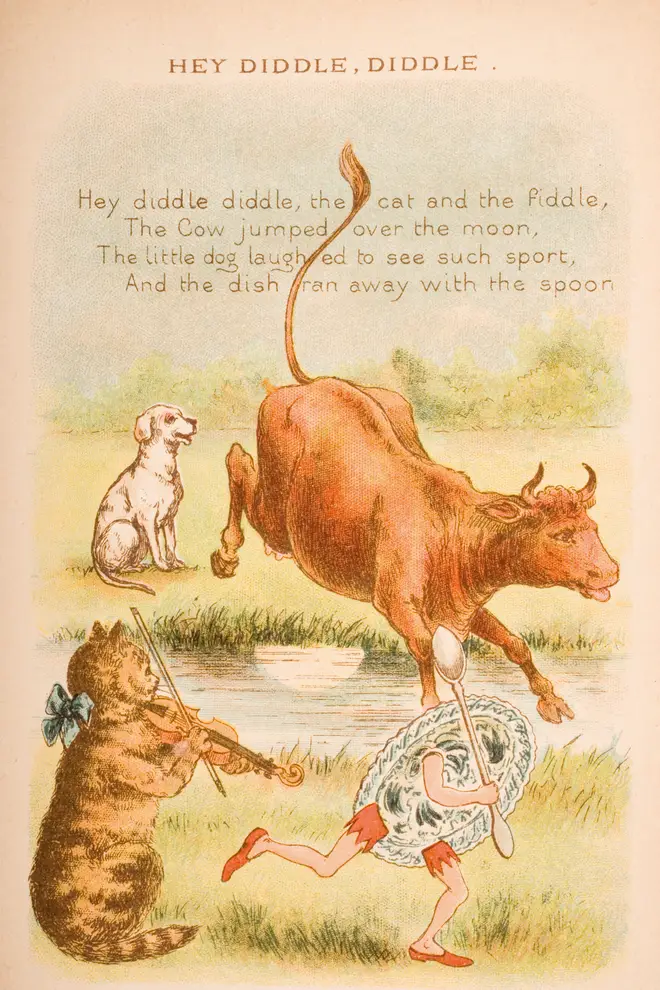On Air Now
The Classic FM Hall of Fame Hour with Tim Lihoreau 9am - 10am
3 August 2021, 20:32 | Updated: 6 August 2021, 12:35

There are cats and fiddles, cows jumping moons, dogs giggling, and dishes that run, literally, taking spoons along with them – what’s ‘Hey Diddle Diddle’ all about?
‘Hey Diddle Diddle’ is an 18th-century English ‘Mother Goose’ nursery Rhyme.
If we take it literally, the traditional nursery rhyme’s lyrics tell of a cat and a fiddle (it doesn’t say if that cat ever played said violin), a cow that jumped over the moon, a laughing dog, and a plate that ran away with a spoon.
But what is the deeper meaning of the rhyme? How did that cow get to such lofty heights, and why did the dish run away with the spoon? Let’s delve into this mysterious and wonderfully lively children’s song…
Read more: The surprising musical origins of ‘Humpty Dumpty Sat on a Wall’
Hey, diddle, diddle,
The cat and the fiddle,
The cow jumped over the moon;
The little dog laughed,
To see such sport,
And the dish ran away with the spoon.
‘Hey Diddle Diddle’ is a single, six-line rhyme. The third line, rather wonderfully, is where the expression to be ‘over the moon’, meaning elated, comes from.

In ‘Hey Diddle Diddle’, not all may be as it seems and, accordingly, scholars on the whole have reached the conclusion that it’s not meant to mean much at all; that it’s just incoherent, humorous nonsense.
‘Diddle’ is defined, in Oxford Dictionary, as either the act of getting “money or some advantage from somebody by cheating them”, or “wasting time without having a purpose.”
The Cat and Fiddle is a common name for inns in England, and the cow jumping over the moon could be a metaphor for… well, it’s not too clear. Maybe the dog is laughing and light-headed after too many ales? And how a dish can even run, we’re not sure. So the above scholarly conclusion that it’s not really meant to make sense seems sensible to us.
One credible theory, though, could be linked to those Cat and Fiddle pubs. An old game involving a trap-ball called a ‘cat’ used to be played at pubs, with accompanying music from the fiddle – which explains why it became a pub name at all. Famous nursery rhymes can sometimes be traced back to traditional dances or musical games, so it’s a plausible theory that that’s what ‘Hey Diddle Diddle’ is all about. And as well as the cat and fiddle, the rhyme mentions “sport”. Perhaps the dish and spoon running away is us, distracted by the game, missing our chance to eat our grub before the plate is carried away again.
James Halliwell-Phillipps, a 19th-century Shakespeare scholar and collector of English nursery rhymes, also had a theory that it was a corruption of ancient Greek sayings, but this has been all but discredited.
Another theory believes the rhyme has everything to do with the stars in the night sky – that the figures correspond with constellations, with the moon-jumping cow being Taurus the bull and the laughing dog being Canis minor.

Old MacDonald in the Style of Beethoven
There are even Ancient Egyption themes that creep into the theories of ‘Hey Diddle Diddle’.
And there’s one more area of speculation worth mentioning: the history-based theories that the rhyme depicts either Lady Katherine Grey, a granddaughter of Henry VIII’s sister Mary, who had dual relationships with the Earl of Hertford and the Earl of Leicester, or Catherine of Aragon, Henry VIII’s first wife. The “diddle” is fitting for the speculation and cheating that has been recorded as apparent in Tudor politics.
In 1923, Lord of the Rings author J. R. R. Tolkien satirised ‘Hey Diddle Diddle’ and all the theories surrounding its meaning, in his original song ‘The Man in the Moon Stayed Up Too Late’ – first published in Yorkshire Poetry magazine and then again in Lord of the Rings.
‘Hey Diddle Diddle’ is believed to originate from the 1700s, with the lyrics and melody we know today first published by the composer and nursery rhyme collector James William Elliott, in his 1870 collection National Nursery Rhymes and Nursery Songs.
Many historians believe the rhyme could be even older, dating back to the 16th century or further.
When he wrote story versions of the Mother Goose nursery rhymes in 1897, Wizard of Oz author L. Frank Baum retold ‘Hey Diddle Diddle’ from a little boy’s perspective. The boy saw the cat having a mishap and panicking after getting stuck to a fiddle, the cow jumping over the reflection of the moon in water, the dog simply running around and barking with excitement, and the dish and spoon being those from his own supper, sliding into a brook.
What a wonderfully concise way of bringing the mysterious ‘Hey Diddle Diddle’ out of the realms of nonsense rhyme, and into something really quite everyday and plausible.